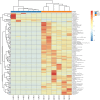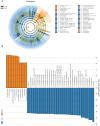Battery pollutant leakage disrupts antioxidant ability and gut microbial homeostasis of chickens
- PMID: 41181318
- PMCID: PMC12575344
- DOI: 10.3389/fcimb.2025.1682969
Battery pollutant leakage disrupts antioxidant ability and gut microbial homeostasis of chickens
Abstract
Over the past few decades, battery industry and electronic equipment have undergone explosive growth, but the heavy metal waste generated has led to significant global ecological and public health challenges. Currently, increasing evidences have confirmed the detrimental effects of heavy metal exposure on animal reproduction, immunity, and metabolism. However, research focused on the impacts of battery leakage on the gut microbiota remain scarce. Thus, this study aims to investigate the detrimental effects of battery on gut microbiota in chickens. Results revealed that battery exposure can lead to a significant increase in spleen index and a significant decrease in thymus index in chickens. Furthermore, battery exposure can significantly increase serum ALT, AST and MDA levels, and while concurrently reducing levels of GSH-Px and SOD. Battery exposure also cause a significant reduction in the gut microbial alpha diversity, accompanied by significant alterations in taxonomic composition. Bacterial taxonomic analysis indicated that the relative abundances of 1 phyla and 4 genera increased dramatically, while the relative abundance of 3 phylum and 115 genera decreased significantly during battery exposure. In conclusion, this study suggests that battery exposure leads to gut microbial dysbiosis and affect antioxidant ability in chickens. The significant alterations of gut microbiota may represent one of the mechanisms through which battery exerts its intestinal and renal toxicity. Given the context of battery pollutant leakage and inadequate recycling supervision, this study contributes to providing impetus for environmental protection agencies and organizations worldwide to enhance the recycling of battery waste.
Keywords: battery; chicken; diversity; gut microbiota; pollutant.
Copyright © 2025 Qin, Song, Xiang, Wang, Luo, Yang and Wen.
Conflict of interest statement
Author SW was employed by Zhejiang Hisun Animal Healthcare Products Co., Ltd. The remaining authors declare that the research was conducted in the absence of any commercial or financial relationships that could be construed as a potential conflict of interest.
Figures










References
-
- Akkerman R., Oerlemans M., Ferrari M., Fernandez-Lainez C., Walvoort M., de Vos P. (2025). Exopolysaccharides from bifidobacterium longum subsp. Infantis and bifidobacterium adolescentis modulate toll-like receptor signaling. Carbohydr. Polym. 349, 123017. doi: 10.1016/j.carbpol.2024.123017, PMID: - DOI - PubMed
-
- Boesmans L., Valles-Colomer M., Wang J., Eeckhaut V., Falony G., Ducatelle R., et al. (2018). Butyrate producers as potential next-generation probiotics: safety assessment of the administration of butyricicoccus pullicaecorum to healthy volunteers. mSystems 3, e00094-18. doi: 10.1128/mSystems.00094-18, PMID: - DOI - PMC - PubMed
MeSH terms
Substances
LinkOut - more resources
Full Text Sources
Medical
Miscellaneous

